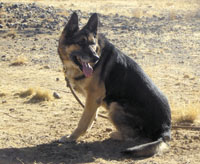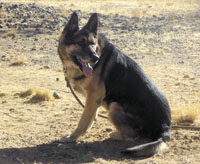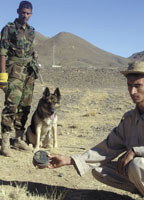
Yemen uses German shepherds to find long-buried landmines [Archives:2008/1131/Last Page]
February 21 2008
 |
 |
Hamed_thabit@hotmail.com
At a military base not far from an upscale Sana'a hotel, one can hear the cacophonous sound of dogs barking as soon as you drive up. But these barking dogs aren't your average pets or guard dogs. These dogs are used to detect landmines left over from 30 years of conflicts in Yemen.
From the 1962 revolution through the 1994 Civil War, Yemen has witnessed several conflicts, each leaving behind a significant number of landmines. Governorates such as Abyan, Amran, Lahj, Al-Dhale', Al-Beidha and Hadramout are especially affected by these explosive remnants of armed conflict.
Trained dogs are the preferred method for removing landmines because they are reliable, quick, cheap and high quality.
Although Yemen has signed and ratified the United Nations treaty banning landmines, there's no domestic law to implement it.
Mine detection dogs come to Yemen
In 2000, on behalf of Yemen, the German government contracted de-mining dog experts from a canine landmine detection center in Kabul, Afghanistan.
The Afghan de-mining center was donated by the German government, as are nearly all the of the services to train the Yemeni dog handlers and mine dogs, instructors, field supervisors, veterinarians, set leaders and mine dog group leaders, according to Col. Ahmed Al-Kathar, director of the Mine Dog Center located in Sana'a.
When the first Afghan group arrived in Sana'a in August 2001, the group included one dog trainer, two mine dog set leaders, five dog handlers and five German shepherd mine detection dogs, noted Abdulwahid Leywal, the center's Afghani supervising director.
Following a trial run in Al-Dhale' governorate in December 2001, the Yemeni Executive Mine Action Center, which oversees the Sana'a Mine Dog Center, accepted the de-mining dog team and began training Yemeni personnel, Al-Kathar added.
The center originally was located in Aden, but some of the dogs died due to the intense heat there, so it relocated to Sana'a, initiating its own breeding program in April 2004.
Training
Training for de-mining dogs consists of 18 months of breeding, socialization and training. The dogs then receive two months of explosives training and lastly, a month-long pre-deployment training. During the training, the dogs are taught to recognize the scent of TNT.
The landmine search process goes like this: a dog first walks the area where landmines have been laid, sniffing for TNT. It then sits next to the mine at a distance of 30 centimeters, while a second dog does the same to ensure that it's actually a landmine.
After this, the dog's leaders will put a small mark next to the mine to signal that it's ready for mine diffusion experts to come to the site.
“Some types of land, such as desert area, aren't good for the dogs,” noted Leywal. He adds that when the Yemeni Executive Mine Action Center requests help from the Mine Dog Center, they first must check the that land is appropriate for using the de-mining dogs and ensure that mines can indeed be found.
Each landmine is different, with many containing varying amounts of explosive material. Al-Kathar says he won't take dogs to areas with both small explosive mines (9 grams of TNT) and larger explosives with 200 kilograms of TNT, explaining, “When dogs catch the scent of the TNT, they go after the ones with more gunpowder and leave the other [smaller] ones,” which could result in killing them.
“An Afghan veterinarian is on hand to assist the other veterinarians in a dog clinic, so if anything does happen, they're prepared for surgery,” Al-Kathar noted.
“The most important aspect is the weather. A dog's leader first must determine the direction of the wind before allowing his dog to go into the field because if the wind is blowing straight into the dog's face, it'll be in danger because it can't smell the TNT well,” explained Nabil Morshed and Abdullah Othman, two of the Mine Dog Center's dog trainers, “So the wind must come from the left, right or behind.”
Whereas there were only five de-mining dogs in 2001, this year, 38 dogs will be ready to search for landmines, most of them 100-percent Yemeni bred.
The MDC currently employs 61 mine dog handlers, 23 mines dog set leaders, 38 mine dogs eight para-veterinarians, seven supervisors, six mine group leaders, four mine instructors, four kennel masters and one supervising veterinarian.
The center serves the dogs special food shipped directly from Germany. Adult dogs eat only one meal a day while puppies eat twice a day, since their growing bodies need more energy.
Dogs may work for roughly 10 years, after which they are tested to ensure that they are able to continue working for a few more years. If a dog fails this testing, the center retires it.
——
[archive-e:1131-v:15-y:2008-d:2008-02-21-p:lastpage]


